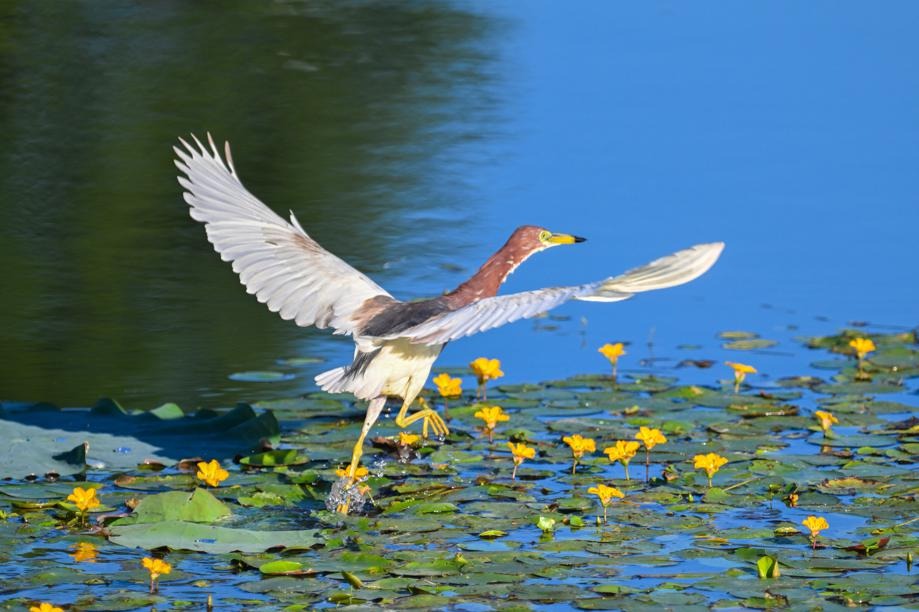Reserve's AI system takes the strain out of monitoring avian species


An artificial intelligence monitoring system in the heart of the Yellow River Delta National Nature Reserve in Dongying, Shandong province, is helping conservationists keep a close eye on the breeding patterns of the Oriental stork.
Conservationists at the reserve used cameras to observe the birds laying eggs and hatching chicks. On Feb 2, World Wetlands Day, they witnessed an Oriental stork lay its first egg on an artificial nest. A month later, the egg hatched successfully, producing a healthy chick.
Lu Xiuming, an AI monitoring officer at the reserve, said: "We stood in front of a big screen and watched every move the birds made. We felt that the AI monitoring technology was very good."
The Yellow River Delta is one of the world's most important sites for migratory birds, but monitoring and protecting them has been a challenging task that relies heavily on human labor.
"Initially, bird surveys were conducted purely by humans. Members of the monitoring team needed to walk to every area of the reserve to count the birds individually and record the data," Lu said.
The AI system, which is undergoing a trial operation in the reserve's core area, has significantly improved conservation efforts.
Optical cameras and edge AI processors are used to photograph and identify birds in real time, record their sightings, and store data for further analysis. Such processors provide computing power at the edge of a network.
The system recognizes dozens of avian species and tracks their population changes based on their features, such as tail, feet and beak. It can also detect abnormal behavior or signs of distress among the birds.
Lu said: "The system automatically recognizes the red skin around the eyes of the Oriental stork and its black beak. If a stork walks or flies in an unusual way or lies on the ground motionless for a long time, the system detects this and alerts us, so that we can take quick protective measures."
Furthermore, the system monitors bird behavior and habitat changes day and night, allowing conservationists to analyze continuous data and uncover new behavioral patterns that were previously difficult to detect.
Shan Kai, the reserve's senior engineer, said the system has already proven its worth by tracking the Oriental stork's complete breeding cycle.
"Previously, we could only observe the birds intermittently. Thanks to the AI system, we can now monitor the complete life cycle of the Oriental stork in real time and detect changes as they happen, providing a more holistic view of the entire process," Shan said.
Oriental storks began breeding at the reserve in 2003. Although the first attempt was unsuccessful, natural reproduction of the species was observed in the wild in 2005, and the numbers have grown steadily since then.
More than 2,700 Oriental white stork chicks have been born at the reserve since 2005, making it the largest breeding ground for the species in the world.
However, the AI system is not perfect. It sometimes confuses one bird with another, or even mistakes a stone or reed for a bird.
"It was like a wayward child at first, causing many problems, but with continuous learning, it has become much more intelligent and accurate," Shan said.
To improve AI recognition, for example, frames from video footage of the storks need to be captured and extracted. The frames are then manually categorized into eight different behavioral patterns, and the system then uses this foundational data to perform intelligent recognition.
Shan said the accuracy level of the bird identification system rose to more than 90 percent as the sample size and data volume gradually increased.
In addition to its main function of bird monitoring, the system alerts conservationists to any unauthorized human activity in areas off-limits to the public, where the birds congregate, while also serving as an educational platform for the public.
"Visitors can access real-time monitoring resources," Shan said, adding the reserve even experimented with slow livestreaming, which attracted 100 million visits during March and May last year.
Human patrols are still used to gain an overall understanding of avian populations in particular locations at specific times. "The two methods complement each other and are not interchangeable," Shan added.
To further develop the AI system, the reserve is working with research institutes and high-tech enterprises such as Huawei.
- Smart agriculture provides solutions for BRI countries
- Foreign experts, journalists explore China's cultural heritage
- Jiangxi county pioneers innovative rural development approach
- China's 'medicine capital' company goes fully automated
- Beijing prosecutors helping errant minors to get back on track
- Copyright Society of China wins approval to be observer of world intellectual property body





































